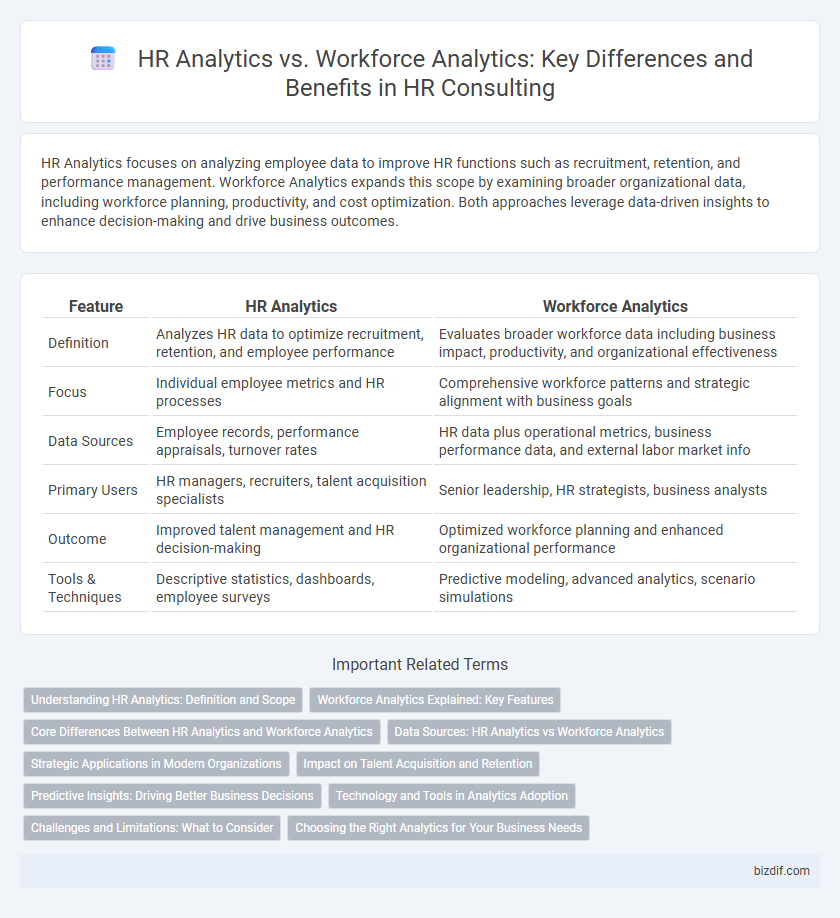HR Analytics focuses on analyzing employee data to improve HR functions such as recruitment, retention, and performance management. Workforce Analytics expands this scope by examining broader organizational data, including workforce planning, productivity, and cost optimization. Both approaches leverage data-driven insights to enhance decision-making and drive business outcomes.
Table of Comparison
| Feature | HR Analytics | Workforce Analytics |
|---|---|---|
| Definition | Analyzes HR data to optimize recruitment, retention, and employee performance | Evaluates broader workforce data including business impact, productivity, and organizational effectiveness |
| Focus | Individual employee metrics and HR processes | Comprehensive workforce patterns and strategic alignment with business goals |
| Data Sources | Employee records, performance appraisals, turnover rates | HR data plus operational metrics, business performance data, and external labor market info |
| Primary Users | HR managers, recruiters, talent acquisition specialists | Senior leadership, HR strategists, business analysts |
| Outcome | Improved talent management and HR decision-making | Optimized workforce planning and enhanced organizational performance |
| Tools & Techniques | Descriptive statistics, dashboards, employee surveys | Predictive modeling, advanced analytics, scenario simulations |
Understanding HR Analytics: Definition and Scope
HR Analytics involves collecting and analyzing employee-related data to improve recruitment, performance management, and retention strategies by uncovering patterns and insights within HR processes. The scope of HR Analytics extends across talent acquisition, employee engagement, workforce productivity, and compensation planning, enabling data-driven decision-making in human resource management. Workforce Analytics, often considered a subset, emphasizes broader organizational metrics like labor costs, headcount forecasting, and workforce segmentation to optimize overall workforce planning and efficiency.
Workforce Analytics Explained: Key Features
Workforce Analytics focuses on analyzing employee data to improve workforce planning, productivity, and retention by leveraging metrics such as employee performance, turnover rates, and engagement levels. It uses advanced data models and predictive analytics to identify trends and forecast workforce needs, enabling data-driven decision-making in talent management. Key features include real-time data integration, comprehensive dashboard reporting, and customizable analytics tailored to organizational goals.
Core Differences Between HR Analytics and Workforce Analytics
HR Analytics primarily focuses on analyzing employee data related to recruitment, performance, retention, and engagement to improve human capital management. Workforce Analytics encompasses a broader scope, integrating operational data such as labor costs, productivity, and workforce planning aligned with business objectives. The core difference lies in HR Analytics centering on individual employee metrics, while Workforce Analytics includes organizational-level insights for strategic decision-making.
Data Sources: HR Analytics vs Workforce Analytics
HR Analytics primarily relies on internal human resources data sources such as employee records, payroll, performance evaluations, and recruitment metrics to extract insights. Workforce Analytics incorporates a broader range of data sources including operational data, business outcomes, employee engagement surveys, and external labor market trends to provide a comprehensive view of workforce effectiveness. Integrating diverse data sources in Workforce Analytics enables strategic decision-making that aligns HR initiatives with overall business goals.
Strategic Applications in Modern Organizations
HR Analytics focuses on interpreting employee data to optimize talent management and enhance workforce productivity, while Workforce Analytics extends this by integrating operational insights to align human capital with strategic business goals. Modern organizations leverage these analytics to predict employee performance, reduce turnover rates, and improve leadership effectiveness through data-driven decision-making. By combining HR and Workforce Analytics, companies achieve a holistic view of workforce dynamics, enabling proactive strategies that support organizational growth and competitive advantage.
Impact on Talent Acquisition and Retention
HR Analytics focuses on analyzing employee performance, engagement, and turnover patterns to enhance talent acquisition strategies and improve retention rates. Workforce Analytics provides a broader scope by examining organizational workforce trends, skills gaps, and demographic data to optimize recruitment processes and long-term workforce planning. Integrating HR Analytics with Workforce Analytics drives data-driven decisions that significantly increase hiring efficiency and reduce employee attrition.
Predictive Insights: Driving Better Business Decisions
HR Analytics focuses on analyzing employee data to improve talent management and operational efficiency, while Workforce Analytics encompasses a broader scope including organizational performance and labor market trends. Predictive insights derived from HR Analytics enable businesses to forecast employee turnover and optimize recruitment strategies, leading to reduced costs and enhanced productivity. Workforce Analytics leverages predictive models to align workforce planning with business goals, improving strategic decision-making and driving organizational growth.
Technology and Tools in Analytics Adoption
HR Analytics leverages advanced technologies such as AI-driven platforms, predictive modeling, and cloud-based HRIS systems to analyze employee data and optimize talent management. Workforce Analytics often incorporates integrated tools like workforce planning software and real-time labor market analytics to align staffing strategies with business outcomes. Both domains increasingly adopt machine learning algorithms and data visualization tools to enhance decision-making and drive strategic HR initiatives.
Challenges and Limitations: What to Consider
HR Analytics faces challenges such as data privacy concerns, integration difficulties, and the need for skilled analysts to interpret complex datasets, which can limit its effectiveness. Workforce Analytics often struggles with incomplete employee data, resistance to data-driven decision-making, and aligning analytics outcomes with strategic HR goals. Both approaches require careful consideration of data quality, organizational culture, and the balance between technology and human insight to maximize their impact.
Choosing the Right Analytics for Your Business Needs
HR Analytics focuses on analyzing employee data such as performance, engagement, and retention to improve talent management strategies, while Workforce Analytics provides a broader scope by examining organizational data like labor costs, productivity, and workforce planning. Choosing the right analytics depends on specific business objectives, whether optimizing human capital or driving operational efficiency. Tailoring analytics tools to your company's size, industry, and strategic goals ensures actionable insights that align with overall business performance.
HR Analytics vs Workforce Analytics Infographic

 bizdif.com
bizdif.com